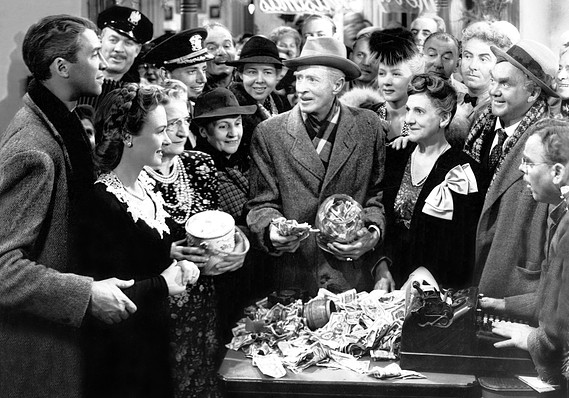 Courtesy Everett Collection
Courtesy Everett Collection
You can kiss George Bailey’s mortgage market goodbye.
As the small-town banker in Frank Capra’s “It’s a Wonderful Life,” Bailey epitomized an old-fashioned world in which bankers know every borrower personally. In the mortgage market of 2019, borrowers can do just about everything online, never meeting the lender behind the process.
And as comments from executives of America’s biggest banks made clear last week, that person – or institution – making the loan is increasingly less likely to be a banker.
In an earnings report last week, JPMorgan Chase JPM, +0.76% said that mortgage originations were down 18% compared to a year ago in the first quarter. For Wells Fargo WFC, +0.95% , which reported earnings the same day, mortgage lending was down 23% compared to the year earlier. (Wells Fargo is still the largest originator of mortgages in the U.S., with a 10.7% market share in 2018, according to Inside Mortgage Finance.)
Earlier coverage: Why mortgage lending at Wells Fargo, Chase and Citi plunged
Jamie Dimon, JPM’s CEO, said this in his shareholder letter released at the same time as Q1 earnings:
“In the early 2000s, bad mortgage laws helped create the Great Recession of 2008. Today, bad mortgage rules are hindering the healthy growth of the U.S. economy. Because there are so many regulators involved in crafting the new rules, coupled with political intervention that isn’t always helpful, it is hard to achieve the much-needed mortgage reform. This has become a critical issue and one reason why banks have been moving away from significant parts of the mortgage business.”
Because of post-crisis capital rules, “owning mortgages becomes hugely unprofitable,” Dimon lamented later in his note. On a call with analysts, he called mortgage servicing – the bookkeeping for regular customer payments – hard. “You got to look at that and ask a lot of questions about whether banks should even be in it,” Dimon said.
If not banks, then, who should be “in it”? “Non-banks are becoming competitors,” Dimon told analysts.
Read: The average adjustable-rate mortgage is nearly $700,000. Here’s what that tells us.
In contrast, Wells Fargo executives sounded hopeful for a pick-up in mortgage lending, at least in the short term. “We expect to see a higher origination volume in Q2 due to typical seasonality for home buying as well as some additional refinance activity resulting from the recent decrease in mortgage interest rates,” they said in prepared remarks on an earnings call.
“Mortgage lending is core to Wells Fargo,” CFO John Shrewsberry said in response to an analyst question. But moments later, he added, “I think non-bank competitors both on the origination and servicing side are here to stay.”
See: Wells Fargo readies its first post-crisis mortgage bonds
What exactly is a non-bank? That term generally describes any lender that does not hold deposits, like a bank does. Non-banks lend mortgages that will be guaranteed by Fannie Mae, Freddie Mac, the Federal Housing Administration, or other agencies. In contrast, many banks still hold some mortgages in their own portfolios.
Banks’ retreat from mortgage-making isn’t new, and MarketWatch has covered the issue in the past. But the executive commentary this quarter seemed particularly stark.
Some housing industry participants have raised concerns about the non-bank business model. In 2016, MarketWatch profiled Ted Tozer, who was then head of Ginnie Mae, the massive government entity that includes FHA and other mortgage agencies.
One of the biggest concerns shared by Tozer and other analysts is that while non-banks must hew to the same lending standards, they must depend on banks for short-term financing. “My big concern is starting to have a contagion, similar to 2008, where people quit lending to each other and at that point the whole system had issues because no one knew who to lend to,” Tozer said at the time.
In response, Bill Emerson, CEO of the largest non-bank originator, Quicken Loans, said, “When I think about access to governmental funds, history hasn’t proved that that’s been a great solution for anyone.” (Quicken Loans had 5.1% of the mortgage market in 2018, according to Inside Mortgage finance, making it the number-three lender in the country.)
Non-banks have taken a bigger and bigger share of the mortgage market, as both Shrewsberry and Dimon acknowledged. They had 25% of overall single-family volume in 2008, and 54% in 2017, according to the Mortgage Bankers Association.
The mortgage industry is adamant that non-banks are subject to so much scrutiny that they could never cause a major financial system snafu. In fact, the MBA points out that some guardrails that ostensibly make banks safer, like the FDIC’s deposit insurance, simply mean that taxpayers are on the hook for failures.
It’s worth noting that there was a lot missing in that Hollywood vision of a salt-of-the-earth community banker, like practices that explicitly excluded people of color from getting bank loans. But the debate over whether it’s safer for everyone if lenders have some “skin in the game” when making mortgages is likely to continue.
See also: Meet the little bank that’s helping immigrants achieve big American Dreams


